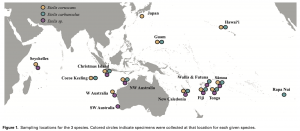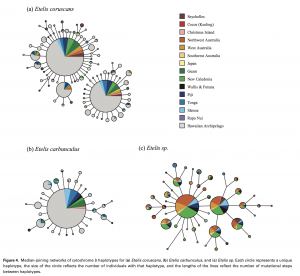 About the author: Sabrina Heiser (she/her/hers) is a PhD Candidate in Dr. Charles D. Amsler’s lab at the University of Alabama at Birmingham. Her research focuses on the factors driving the geographic distribution of chemical defenses in a red seaweed. For her sample and data collection, she gets to go and SCUBA dive in Antarctica. She received her B.Sc. in Marine Biology from Plymouth University (UK) and is originally from Germany. Follow her adventures on her website or @SabrinaHeiser.
About the author: Sabrina Heiser (she/her/hers) is a PhD Candidate in Dr. Charles D. Amsler’s lab at the University of Alabama at Birmingham. Her research focuses on the factors driving the geographic distribution of chemical defenses in a red seaweed. For her sample and data collection, she gets to go and SCUBA dive in Antarctica. She received her B.Sc. in Marine Biology from Plymouth University (UK) and is originally from Germany. Follow her adventures on her website or @SabrinaHeiser.
For shallow-water organisms, there generally seems to be a separation between the Pacific and Indian Oceans. Habitats within these ocean basins are geographically isolated (such as Hawai’i, Fiji, or the Red Sea) and do not have many newcomers.
As we get into deeper and darker habitats, our knowledge about genetic connectivity seems to disappear. Andrews et al. (2020) looked at the connectivity of three Etelis snapper species (Figure 1).

The larvae of these slow-growing, long-lived species (most of them can grow older than I am right now) remain for a long time in the water column and are found further offshore than their shallow-water counterparts. But does this mean that they also travel further?
The distribution ranges vary slightly between the three snapper species (Figure 2) and one of the species (E. coruscans) has a more adventurous lifestyle by feeding up to 50m above the sea floor. In order to investigate the genetic connectivity of the snapper species, the authors used the mitochondrial cytochrome b gene for all three species and microsatellite markers for two of the species.

Shallow-water species have shallower coalescence, bottlenecks caused by changes in sea-level as a result of glaciation. Surprisingly, the same pattern was found in the three deeper water snappers (Figure 3). Even though these three species should have been less affected by sea-level changes. Andrews et al. (2020) hypothesize that bottlenecks nevertheless occur as only few females successfully produce the majority of the next generation.

In contrast to shallow-water species, the deeper water fish species showed less population structure with only fish in Hawai’i and the Seychelles in the western Indian Ocean having some genetic differentiation. These findings align well with the above-mentioned differences in their larval stages. The most adventurous species (E. coruscans) had the least population structure. Shallow water species often observe a strong divide due to the Indo-Pacific barrier (a terrestrial divide during low sea-level). The three Eteline snapper species lack this pronounced division, likely due to their dispersal abilities (Andrews et al. 2020).
Andrews et al. (2020) agree with other studies that have found low population structure in deep-water species of fish making them more similar to pelagic fish than to shallow-water species in terms of their population structure. However, in order to determine the drivers of these patterns (or lack thereof), researchers still have to dive deeper into the topic.
References



